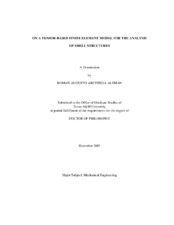| dc.description.abstract | In the present study, we propose a computational model for the linear and nonlinear
analysis of shell structures. We consider a tensor-based finite element formulation which
describes the mathematical shell model in a natural and simple way by using curvilinear
coordinates. To avoid membrane and shear locking we develop a family of high-order
elements with Lagrangian interpolations.
The approach is first applied to linear deformations based on a novel and consistent
third-order shear deformation shell theory for bending of composite shells. No
simplification other than the assumption of linear elastic material is made in the
computation of stress resultants and material stiffness coefficients. They are integrated
numerically without any approximation in the shifter. Therefore, the formulation is valid
for thin and thick shells. A conforming high-order element was derived with 0 C
continuity across the element boundaries.
Next, we extend the formulation for the geometrically nonlinear analysis of
multilayered composites and functionally graded shells. Again, Lagrangian elements
with high-order interpolation polynomials are employed. The flexibility of these
elements mitigates any locking problems. A first-order shell theory with seven
parameters is derived with exact nonlinear deformations and under the framework of the Lagrangian description. This approach takes into account thickness changes and,
therefore, 3D constitutive equations are utilized. Finally, extensive numerical
simulations and comparisons of the present results with those found in the literature for
typical benchmark problems involving isotropic and laminated composites, as well as
functionally graded shells, are found to be excellent and show the validity of the
developed finite element model. Moreover, the simplicity of this approach makes it
attractive for future applications in different topics of research, such as contact
mechanics, damage propagation and viscoelastic behavior of shells. | en |


